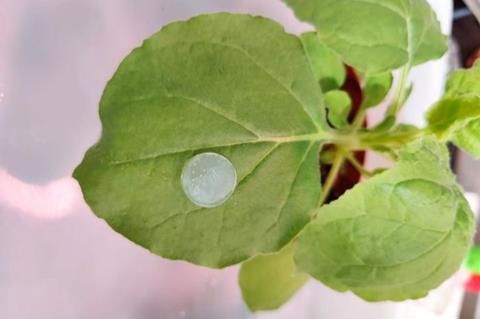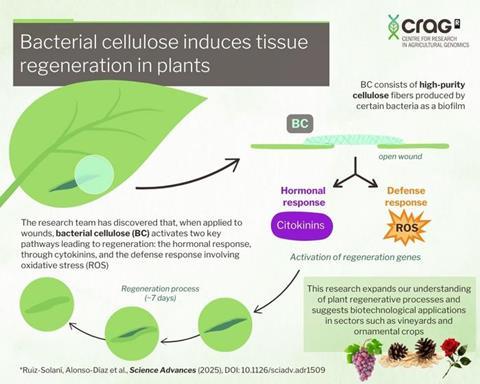A groundbreaking study, co-led by researchers from the Center for Plant Biotechnology and Genomics (CBGP) and Centre for Research in Agricultural Genomics (CRAG), has elucidated the mechanism by which bacterial cellulose mediates plant tissue regeneration. The work has been published today in the prestigious journal Science Advances and includes collaborations with researchers of the Institute of Materials Science of Barcelona (ICMAB-CSIC) and Colorado State University.

Bacterial cellulose (BC), synthesized by certain bacteria as a biofilm, consists of highly pure cellulose fibers. BC has been widely used in human biomedical applications showing a high degree of biocompatibility, but its potential healing effects in plants were unknown.
In this work, scientists have demonstrated that BC patches induce plant tissue regeneration and have identified for the first time the precise molecular mechanism underlying the process. Wounded leaves of the model plants Nicotiana benthamiana and Arabidopsis thaliana were covered with BC patches and formation of new cells on both sides of the cut was observed two days post-wounding, reaching complete wound closure after seven days. This wound healing process was promoted by BC but not by other structurally similar matrixes such as plant cellulose, indicating that BC had specific features beyond preventing dehydration or promoting physical contact.
Patches contain cytokinines
Scientists discovered that BC patches contain cytokinines, a class of hormones involved in plant development. “Plants with defective cytokinin signaling did not respond to BC patches, confirming that cytokinines are crucial for triggering regeneration,” explains Nerea Ruiz-Solaní, a co-first author of the study.
READ MORE: Researchers find new way to turn bacteria into cellulose-producing mini-factories
READ MORE: Super-strong bacterial cellulose macrofibers made simple with TAT technique
The team also identified production of oxidative stress (ROS) at the wound sites upon BC application. Genomic and bioinformatic analyses enabled scientists to identify the specific genes involved in the process, which are typically associated with biotic responses, i.e. defense mechanisms against pathogens. The transcription factor WRKY8, which regulates defense responses, was found to interact directly with the promoter of GSTF7 gene leading to ROS accumulation.
Importantly, it is the concurrent activation of both the cytokinin and defense signaling pathways that results in the observed tissue regeneration, a novel finding since these mechanisms were previously studied independently. Further research would be needed to fully elucidate the pathways leading to cell cycle activation and functional differentiation during regeneration.
Unique regeneration program
“Bacterial cellulose triggers a unique transcriptional program that differs from typical wounding-and callus-induced regeneration,” states Miguel Moreno-Risueño, co-leader of the study and an expert in plant regeneration at the CBGP.

This research holds significant implications for agricultural practices, including wound healing to prevent infections, and applications in grafting, pruning, and ornamental plant care, particularly in vineyards, rose cultivation, and stone pine production. This work started a few years ago, back in 2016, with joint projects between CRAG and ICMAB-CSIC research groups led by Núria Sánchez Coll and Anna Laromaine, respectively, and in collaboration with companies such as AGROMILLORA and Forestal Catalana S.A. (Plant Healing and Plant Nanohealing projects), which conducted preliminary field trials. However, further field studies are still needed to confirm the efficacy of BC patches in grafting. More technology transfer resources are needed to bridge the gap between fundamental research and the productive sector, with significant economic implications.
Núria Sanchez Coll, CSIC researcher at CRAG and co-leading author, highlights the collaborative nature of this research: “This work has fostered very interesting collaborations with other research groups as well as industry, paving the way for further studies on plant regeneration mechanisms and potential biotechnological applications.”
Topics
- AGROMILLORA
- Anna Laromaine
- Arabidopsis thaliana
- Bacteria
- bacterial cellulose
- Biofilms
- Center for Plant Biotechnology and Genomics
- Centre for Research in Agricultural Genomics
- Colorado State University
- cytokinines
- Forestal Catalana S.A
- grafting
- Healthy Land
- Institute of Materials Science of Barcelona
- Miguel Moreno-Risueño
- Nerea Ruiz-Solaní
- Nicotiana benthamiana
- Núria Sanchez Coll
- oxidative stress
- plant tissue regeneration
- Research News
- Soil & Plant Science
- UK & Rest of Europe
- USA & Canada







No comments yet